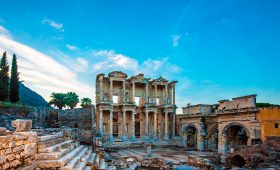HIERAPOLIS, THE CITY OF WATER AND FAITH
The ancient city of Hierapolis, 18 km north of the province of Denizli, was founded by Eumenes II, the King of Bergama in the 2nd century BC and it can be said that Telephos, the legendary founder of Bergama, named Hierapolis after his wife, Hiera. The city was continuously destroyed and rebuilt by earthquakes because it was in an earthquake prone area. However, the buildings that are standing today were built after the great earthquake in AD 60 and after that, the city was constructed with a grid plan, taking the appearance of a typical Roman city that had lost its Hellenistic character. After the Roman period, Hierapolis continued to be a very important center in the Byzantine period. The reason Hierapolis was the center of Christianity since the 4th century AD was that St. Philip, one of Jesus ‘ disciples, was crucified here in AD 80. Kent I.S. After the Byzantine conquest of the 4th century, an octagonal church called Martyrium was built in memory of St. Philip. Therefore, the city gained fame and it got the title “Metropolis”. The city was destroyed by the earthquake in the 7th century AD and lost its identity. It became a small town in the 12th century, then the area came under the control of the Seljuk Sultanate in the 13th century and following the earthquake in the 14 century, it was completely abandoned.
The ancient city had grid plan consisting of two monumental gates and perpendicular streets parallel to the Main Street. The Main Street, which is about 1 km long, divides the city into two and there are arcades, public buildings, shops and workshops on both sides of this street. The necropolis areas outside the city walls and on the north, south and east side of the city are the largest necropolis in Southwest Anatolia. The other significant buildings of the ancient cite are; Bath-Basilica, Latrina, Theater, Ploutonion (a shrine to the Greek god Pluto), Apollon Temple, water canals and The Nymphaeum, churches (St. Philip Martyrium, St. Philip Church) and the antique pool and the baths.
The ancient city of Hierapolis (Pamukkale) whose ruins are mostly from the Roman era, along with the splendid Pamukkale Travertines next to it, was included in the UNESCO World Heritage list as a cultural and natural heritage.
WHILE YOU ARE HERE…
Don’t miss the natural wonders of the white travertine. These thermal pools with terraces attract people looking for beauty and health since the Roman era.




